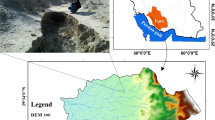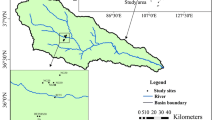Abstract
High soil-conservation herbs are very important for slope vegetation restoration of a highway in serious sandstorm regions. In this study, nine common herbs in northeast China were selected and compared to study soil-conservation effects by using an undisturbed-soil trough scouring method for soil anti-scourability enhancement and hydrostatic collapse method for soil anti-erodibility. Further, principal components analysis was used to identify significant root features that affected soil erosion resistance. Results indicated that different herbs had distinct enhancement effects on soil erosion resistance. Soil anti-scourability enhancement index decreased with increases of soil depth, slope gradient and rainfall amount. Relationship between soil anti-erodibility enhancement index (S) and immersion time (t) is a cubic spline in each different herb type (R 2 ≥ 0.88). Herb root features such as micro-aggregates, organic matter, net leaf weight, thick root length, fine root length and biomass contributed a leading role in soil erosion resistance enhancement effect, and all their common factor variances were more than 0.81. Descending order of soil erosion resistance enhancement effect in soil anti-scourability for nine herbs is Poa pratensis, Medicago sativa, Viola philippica, Rudbeckia hirta, Clematis heracleifolia, Kalimeris indica, Cosmos bipinnata, Hemerocallis fulva and Sedum elatinoides, while the sequence of soil anti-erodibility is M. sativa, S. elatinoides, P. pratensis, R. hirta, H. fulva, V. philippica, C. heracleifolia, C. bipinnata and K. indica. Therefore, we concluded that P. pratensis and M. sativa were the most suitable herbs for resisting soil erosion and recommended to be widely planted for road vegetation recovery in this region.
Similar content being viewed by others
References
J. Burton, K. S. Pregitzer, and R. L. Hendrick, “Relationships between fine root dynamics and nitrogen availability in northern hardwood forests,” Oecologia 125, 389–399 (2000).
M. Burylo, C. Hudek, and F. Rey, “Soil reinforcement by the roots of six dominant species on eroded mountainous marly slopes (Southern Alps, France),” Catena 84, 70–78 (2011).
A. V. Bykov, A. V. Kolesnikov, N. Yu. Kulakova, and N. P. Shabanova, “Accumulation of moisture and soil erosion in the territory of social vole (microtus socialis) settlements in the northern Capspian Lowland,” Eur. Soil Sci. 41, 902–906 (2008).
M. P. Chartier, C. M. Rostagno, and F. A. Roig, “Soil erosion rates in rangelands of northeastern Patagonia: a dendrogeomorphological analysis using exposed shrub roots,” Geomorphology 106, 344–351 (2009).
L. Chen, Course on Soil Experiment (Harbin, 2005) [in Chinese].
S. De Baets, J. Poesen, A. Knapen, and P. Galindo, “Impact of root architecture on the erosion-reducing potential of roots during concentrated flow,” Earth Surf. Proc. Land 32, 1323–1345 (2007).
S. De Baets, J. Poesen, B. Reubens, De. Muys, J. Baerdemaeker, J. Meersmans, “Methodological framework to select plant species for controlling rill and gully erosion: application to a Mediterranean ecosystem,” Earth Surf. Proc. Land 34, 1374–1392 (2009).
M. Fattet, Y. Fu, M. Ghestem, W. Ma, M. Foulonneau, J. Nespoulous, Y. Bissonnais, “Le Stokes effects of vegetation type on soil resistance to erosion: relationship between aggregate stability and shear strength,” Catena 87, 60–69 (2011).
D. R. Greenway, “Vegetation and slope stability,” in Slope Stability, Ed. by M. G. Anderson and K. S. Richards (J. Wiley and Sons Ltd., New York, 1987), pp. 187–230.
S. V. Gubin and A. V. Lupachev, “Soil formation and the underlying permafrost,” Eur. Soil Sci. 41, 574–585 (2008).
G. Gyssels, J. Poesen, E. Bochet, and Y. Li, “Impact of plant roots on the resistance of soils to erosion by water: a review,” Prog. Phys. Geog. 29, 189–217 (2005).
D. Jiang, “Research on soil anti-scourability under different land use types in the Loess Plateau,” Chinese J. Soil Sci. 4, 20–29 (1979).
H. Jiang, F. Jiang, X. Du, and T. Lu, “Evaluation on soil anti-erodibility of soil and water conservation forest,” Chinese J. Applied Ecol. 11, 345–348 (2000).
S. Katuwal, J. Vermang, W. Cornelis, and D. Gabriels, “Effect of root density and vegetable garden compost mulch on erodibility of loamy soil under simulated rain.” The 5th EGU General Assembly (Geophys. Res. Abstracts, Vienna, Austria, 2008), Vol. 10.
V. S. Kursakova, “The effect of perennial herbs on the physical properties of saline soils,” Eur. Soil Sci. 39, 748–752 (2006).
Y. Li, X. Wu, X. Zhu, and J. Tian, “Studies on soil anti-scourability enhancement effect of plant roots in Loess Plateau I: soil anti-scourability enhancement effect by the roots of artificial Pinus tabulaeformis,” J. Soil Water Conserv. 4, 1–5 (1990).
Y. Li, X. X. Zhu, J. Tian, and Y. Huang, “Preliminary research on soil anti-scourability mechanism in the Loess Plateau,” Chinese Sci. Bull. 35, 390–390 (1990).
Y. Li, X. Xu, X. Zhu, and J. Tian, “Effects of plant root on strengthening soil permeability in Loess Plateau,” Chinese Sci. Bull. 37, 366–369 (1992).
K. W. Loades, A. G. Bengough, M. F. Bransby, and P. D. Hallett, “Planting density influence on fibrous root reinforcement of soils,” Ecol. Engin. 36, 276–284 (2010).
L. Lu, Soil-conserving Capacity of Riparian Plants in Three Gorges Reservoir Region (Chongqing, 2006) [in Chinese].
S. Lu, Progress in Plant Rhizosphere Ecology and Biological Control of Root Diseases (Bei**g, 1990) [in Chinese].
S. B. Mickovski and L. P. H. van Beek, “Root morphology and effects on soil reinforcement and slope stability of young vetiver (Vetiveria zizanioides) plants grown in semi-arid climate,” Plant Soil 324, 43–56 (2009).
S. B. Mickovski, P. D. Hallett, M. F. Bransby, M. C. R. Davies, R. Sonnenberg, A. G. Bengough, “Mechanical reinforcement of soil by willow roots: impacts of root properties and root failure mechanism,” Soil Sci. Soc. Am. J. 73, 1276–1285 (2009).
M. Tosi, “Root tensile strength relationships and their slope stability implications of three shrub species in the northern Apennies (Italy),” Geomorphology 87, 268–283 (2007).
S. Peng and Y. Hao, “Dynamics of forest root distribution during forest succession,” J. Sun Yatsen Univ. (Natural Sci. Ed.) 44, 65–69 (2005).
D. Pimentel and N. Kounang, “Ecology of soil erosion in ecosystems,” Ecosystems 1, 416–426 (1998).
P. Puget, C. Chenu, and J. Balesdent, “Dynamics of soil organic matter associated with particle-size fractions of water-stable aggregates,” Eur. J. Soil Sci. 51, 595–605 (2000).
B. Reubens, J. Poesen, F. Danjon, G. Geudens, B. Muys, “The role of fine and coarse roots in shallow slope stability and soil erosion control with a focus on root system architecture: a review,” Trees 21, 385–402 (2007).
J. Shan and D. Tao, “Overseas research dynamics on fine tree roots,” Chinese J. Ecol. 11, 46–49 (1992).
J. M. Tisdall and J. M. Oades, “Organic matter and water-stable aggregates in soil,” J. Soil Sci., 141–163 (1982).
S. Ya. Trofimov, “the regulatory role of soil in the functioning of undisturbed biogeocenoses of the southern taiga,” Eur. Soil Sci. 43, 957–964 (2010).
E. F. Vedrova, “The intensity of organic matter decomposition in gray soils of forest ecosystems in the southern taiga of Central Siberia,” Eur. Soil Sci. 41, 860–868 (2008).
K. Wang, “Effects of plant roots on soil erosion resistance,” Soil Environ. Sci. 10, 250–252 (2001).
Y. Wang, P. Zhang, B. Zhu, W. Ding, Z. Zhang, “Soil anti-scourability in upper-middle reaches of Yangtze River,” J. Yangtze River Sci. Res. Inst. 24, 12–15 (2007).
W. Wu, S. Zheng, Z. Lu, and T. Zhang, “Effect of plant roots on penetrability and anti-scourability of red soil derived from granite,” Pedosphere 10, 183–188 (2000).
S. Xu and B. Zeng, “Enhancement effects of 5 flooding-tolerant species’ roots on soil anti-erodibility in Three Gorges reservoir region,” J. Soil Water Conserv. 22, 13–18 (2008).
M. G. Yurkevich, “Development and structure of root systems of Phleum pretense in monospecies cultures under the influence of the soil conditions and field management,” Eur. Soil Sci. 45, 779–782 (2012).
F. R. Zaidel’man, D. I. Morozova, A. P. Shvarov, and M. V. Batrak, “Vegetation and pedogenesis on pyrogenic substrates of former peat soils,” Eur. Soil Sci. 39, 12–20 (2006).
J. Zhang, G. Liu, S. Ni, B. Zhu, F. Ge, “Research on purple soil anti-scourability under different land use types,” Sci. China (E edition) 33, 61–68 (2003).
J. Zhang, T. Zang, and F. Zeng, “A study on soil anti-scourability enhancement effect of protective forest root system in Rocky Coast,” J. Nan**g Forest. Univ. (Natural Sci. Ed.) 25, 9–12 (2001).
X. Zhang and Z. Shangguan, “Effect of human disturbance on physical properties of soil in artificial Pinus tabulaeformis Carr. forests of the Loess Plateau,” Acta Ecol. Sinica 26, 85–95 (2006).
Author information
Authors and Affiliations
Corresponding author
Additional information
Published in Russian in Pochvovedenie, 2014, No. 12, pp. 1498–1507.
The article is published in the original.
Rights and permissions
About this article
Cite this article
Xu, W., Wang, X., Zhang, Y. et al. A comparison among root soil-conservation effects for nine herbs at the cold region highway in north-eastern China. Eurasian Soil Sc. 47, 1274–1282 (2014). https://doi.org/10.1134/S1064229314120114
Received:
Published:
Issue Date:
DOI: https://doi.org/10.1134/S1064229314120114




